BÖNNIGHEIM, Germany (October 26, 2021) – Researchers will evaluate the effects of the space environment on the human cardiovascular system using the new SmartTex shirt. Developed by the German Aerospace Center (DLR) in cooperation with DSI Aerospace Technology, the medical faculty of Bielefeld University, and textile research partner Hohenstein, SmartTex will use integrated sensors to transfer physiological data from astronauts to Earth via a wireless communication network. SmartTex will be tested as part of the Wireless Compose-2 (WICO2) project by ESA astronaut Dr. Matthias Maurer, who will leave for his six-month ‘Cosmic Kiss’ mission on the International Space Station (ISS) on October 30, 2021.

The SmartTex shirt is intended to provide a continuous picture of the vital functions of astronauts, which will be particularly relevant for future long-term manned space missions to the Moon and Mars. Future transfer of the SmartTex technology to fitness and telemedicine applications is expected.
“During the previous Spacetex (2014) and Spacetex2 (2018) projects, we gathered valuable data on the interaction of the body, clothing, and climate under microgravity conditions,” explains Hohenstein Senior Scientific Expert, Dr. Jan Beringer. The comfort and material insights provided by those experiments with ESA astronaut Dr. Alexander Gerst have been incorporated into Hohenstein’s design of the new SmartTex shirt. “Dr. Maurer can wear his tailor-made shirt comfortably during everyday work on the ISS. We used his body measurements for pattern development and production. We also integrated the sensors, data processors, and communication modules into the shirt so that they interfere as little as possible and are always positioned in the right place, regardless of the wearing situation. This is the prerequisite for reliable measurement of physiological data.”

During the BEAT experiment (Ballistocardiography for Extraterrestrial Applications and long-Term missions), Maurer will be the first astronaut to wear a T-shirt equipped with sensors that measure his ballistocardiographic data such as pulse and relative blood pressure.

For this purpose, the sensors were calibrated in the :envihab research facility at the DLR Institute of Aerospace Medicine in Cologne. Details can also be read on the contraction rate and opening and closing times of the heart valves, which are normally accessible only via sonography or computer tomography. To realistically study the space environment’s effects on the human cardiovascular system, Maurer’s ballistocardiographic data will be recorded before, during and after his stay on the ISS.
Wireless Compose-2 (WICO2)
The project was planned and prepared by the German Aerospace Center (DLR) and its partners DSI Aerospace Technology, Hohenstein and the University of Bielefeld. The wireless communication network reads sensor data and can determine the position of people and objects in space by propagation times of radio pulses. It is also available as a platform for several experiments on the ISS. The data is temporarily stored within the network and read out at regular intervals by the astronauts. These data packets are then transferred to Earth via the ISS link and analyzed by the research teams. It can generate its own energy from artificial light sources via photovoltaic cells.
More on Hohenstein’s aerospace research: Hohenstein.US/Aerospace

Related Reads: Smart Fabrics – The Future of Apparel Industry













